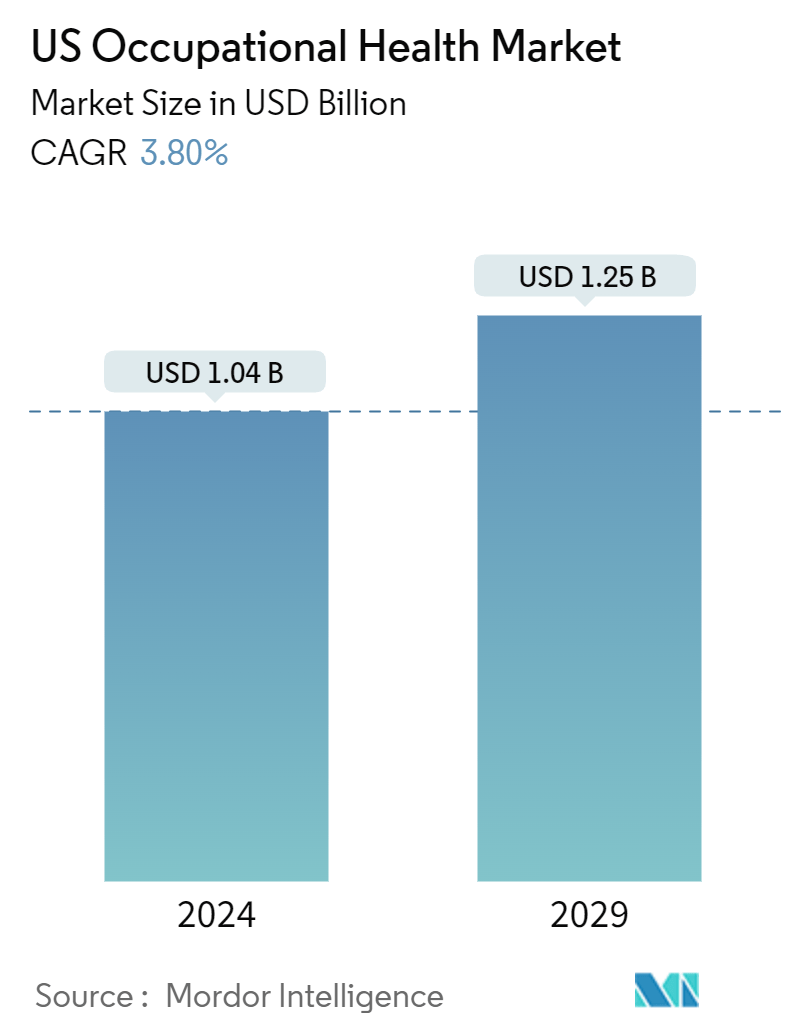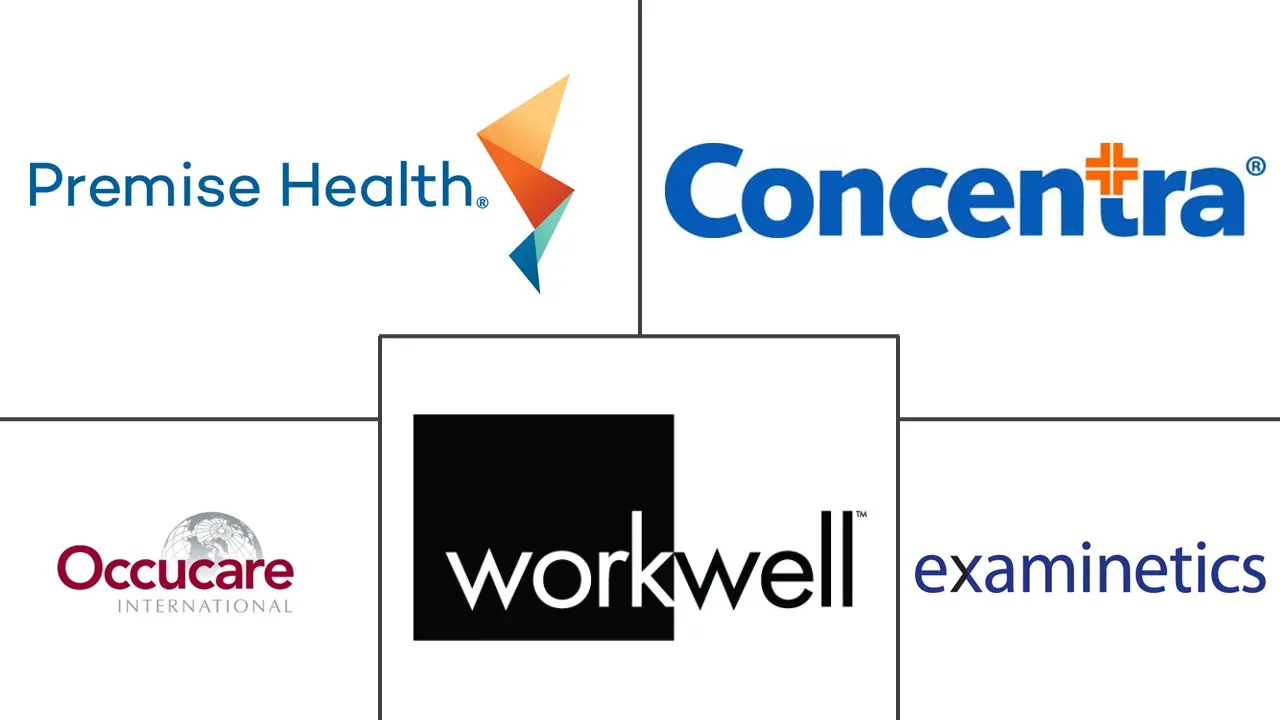Market Size of US Occupational Health Industry

| Study Period | 2019 - 2029 |
| Base Year For Estimation | 2023 |
| Market Size (2024) | USD 1.04 Billion |
| Market Size (2029) | USD 1.25 Billion |
| CAGR (2024 - 2029) | 3.80 % |
| Market Concentration | Medium |
Major Players
*Disclaimer: Major Players sorted in no particular order |
US Occupational Health Market Analysis
The US Occupational Health Market size is estimated at USD 1.04 billion in 2024, and is expected to reach USD 1.25 billion by 2029, growing at a CAGR of 3.80% during the forecast period (2024-2029).
The COVID-19 pandemic was stressful for many people. Many corporations were providing videos and online consultations for reducing and controlling stress. Other strategies, like reimbursements for on-demand and streaming workout videos, were also provided during the pandemic. As a result, the COVID-19 outbreak reinvented the methods to provide essential corporate wellness in times of need. For instance, as per the interim guidance published by the World Health Organization in February 2021, health workers who were infected by COVID-19 as a result of their work and in case the infection is considered an occupational disease or injury in line with national law - was entitled to healthcare, and to the extent that they were incapacitated for work, cash benefits or compensation.
Dependent family members of health workers who died from COVID-19 contracted in the course of work-related activities were entitled to cash benefits or compensation as well as to a funeral grant or benefit. Therefore, COVID-19 had a significant impact on the occupational health market. Currently, many corporations and services are incorporating new strategies to help their employees reduce stress. Hence, the studied market is expected to show a stable growth rate during the forecast period.
Factors such as increasing adoption of workplace wellness programs and a high focus on employer-sponsored medical health coverage coupled with an increasing number of diseases and disorders associated with occupational health are expected to increase the market growth. The high prevalence of extended work hours, heavy workload, and work pressure-related issues create physical and mental repercussions, such as hypertension, heart attacks, and instability among the employees. With the rising competition, employees work under a lot of pressure and excessive demands. Hence, stress disturbs the equilibrium of the work-life balance for the employees.
For instance, according to the Centre for Disease Control and Prevention (CDC) data updated in 2022, the percentage of six or more workdays missed due to illness, injury, or disability in adults aged 18 and over in the United States was 15.6% in 2021, an increase of nearly 4% as compared to the previous year. The high percentage of continuous missing working days is expected to cause anxiety and stress related to workloads, creating the need for occupational medicines and treatment and driving the market's growth.
Furthermore, according to a National Institute of Health, Estimates of Funding for Various Research, Condition, and Disease Categories (RCDC), May 2022 report, the spending on Post-Traumatic Stress Disorder (PTSD) research in the United States was USD 142 million in 2021 and USD 149 million in 2022. Post-traumatic stress disorder (PTSD) can develop after a stressful, frightening, or distressing event or after a prolonged traumatic experience such as a serious accident that necessitates counseling from occupational health physicians. The high spending on research activities in the country is expected to create opportunities for market growth in the upcoming years.
Therefore, owing to the aforementioned factors, such as rising spending for PTSD and factors leading to workload anxiety and occupational illness and injuries, the studied market is anticipated to witness growth over the analysis period. However, increasing automation in industries may hinder the growth pace of the market over the forecast period.
US Occupational Health Industry Segmentation
As per the scope of the report, occupational health deals with the prevention and treatment of work-related injuries and illnesses. Physicians specially trained in occupational health can diagnose and treat work-related injuries more effectively than other primary care physicians.
The United States Occupational Health Market is Segmented By Type (Work-induced Stress, Respiratory Diseases, Musculoskeletal Diseases, Disorders Caused Due to Chemicals and Vibrations, and Other Types). The report offers the market size in value terms in USD for all the abovementioned segments.
| By Type | |
| Work-induced Stress | |
| Respiratory Diseases | |
| Hearing Loss Due to Noise | |
| Disorders Caused Due to Chemicals and Vibrations | |
| Others |
US Occupational Health Market Size Summary
The US occupational health market is poised for growth, driven by an increasing focus on workplace wellness programs and employer-sponsored medical health coverage. The COVID-19 pandemic has significantly influenced the market, prompting companies to adopt innovative strategies to manage employee stress and health. This shift has led to a greater emphasis on corporate wellness, with organizations offering resources such as online consultations and fitness reimbursements. The rising prevalence of work-related stress and its associated health issues, such as hypertension and PTSD, underscores the need for comprehensive occupational health services. As employees face extended work hours and heightened pressures, the demand for occupational health solutions is expected to rise, fostering market expansion.
The market's growth is further supported by the increasing incidence of occupational health diseases and injuries, which necessitate improved health services. The high prevalence of conditions like hearing loss and the rising number of work-related injuries highlight the critical need for effective occupational health interventions. Additionally, research funding for conditions such as PTSD indicates a growing recognition of the importance of mental health in the workplace. Despite the challenges posed by automation, the market is expected to benefit from the efforts of non-governmental organizations and key industry players, who are actively working to enhance occupational health support. This collaborative approach is anticipated to drive significant growth in the US occupational health market over the forecast period.
US Occupational Health Market Size - Table of Contents
-
1. MARKET DYNAMICS
-
1.1 Market Overview
-
1.2 Market Drivers
-
1.2.1 Increasing Adoption of Workplace Wellness Programs and Employer-Sponsored Medical Health Coverage
-
1.2.2 Rising Number of Diseases and Disorders Associated with Occupational Health
-
-
1.3 Market Restraints
-
1.3.1 Increasing Automation in Industries
-
-
1.4 Porter's Five Forces Analysis
-
1.4.1 Threat of New Entrants
-
1.4.2 Bargaining Power of Buyers/Consumers
-
1.4.3 Bargaining Power of Suppliers
-
1.4.4 Threat of Substitute Products
-
1.4.5 Intensity of Competitive Rivalry
-
-
-
2. MARKET SEGMENTATION (Market Size by Value - USD million)
-
2.1 By Type
-
2.1.1 Work-induced Stress
-
2.1.2 Respiratory Diseases
-
2.1.3 Hearing Loss Due to Noise
-
2.1.4 Disorders Caused Due to Chemicals and Vibrations
-
2.1.5 Others
-
-
US Occupational Health Market Size FAQs
How big is the US Occupational Health Market?
The US Occupational Health Market size is expected to reach USD 1.04 billion in 2024 and grow at a CAGR of 3.80% to reach USD 1.25 billion by 2029.
What is the current US Occupational Health Market size?
In 2024, the US Occupational Health Market size is expected to reach USD 1.04 billion.

